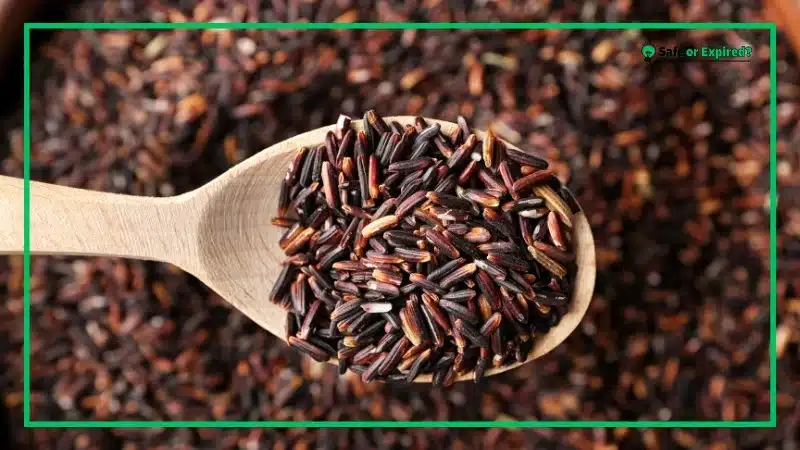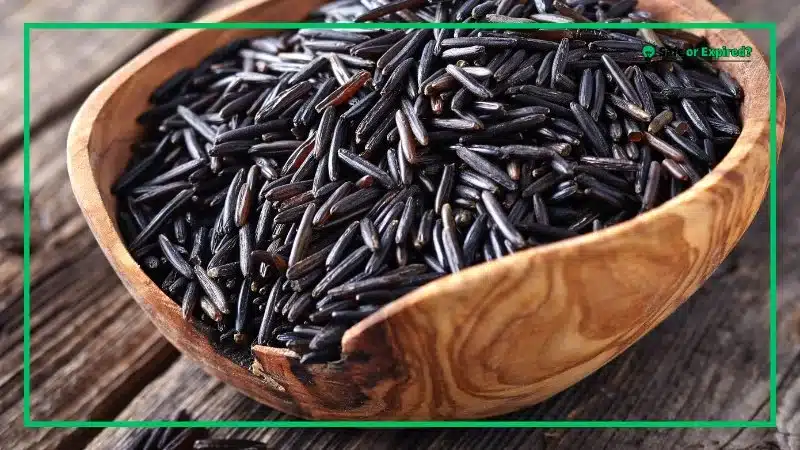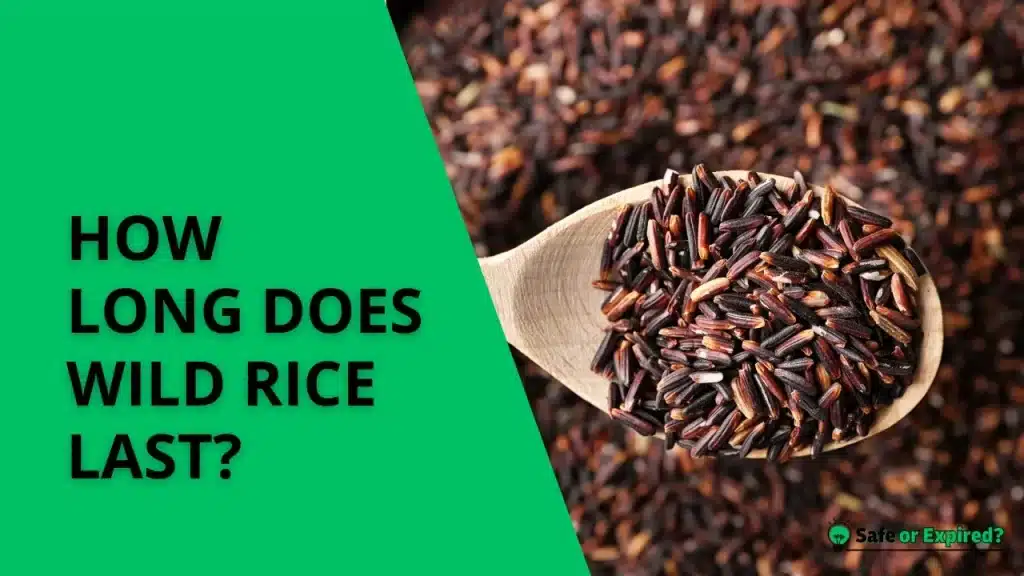“How long does wild rice last?” is a common question for anyone exploring whole grain options. The shelf life is long – from months to years.
The only problem is that you must store the rice properly to enjoy a long shelf life. Worry not; stick around to uncover practical tips to keep your wild rice fresh for years!
How Long Does Wild Rice Last?
Wild rice can last indefinitely when stored in a cool place. Once opened, it usually maintains its quality for about six months. To maximize its shelf life, store wild rice in an airtight container away from heat and light and follow basic food safety guidelines.
People often ask, “How long does wild rice last unopened?” Unopened wild rice can stay fresh and safe to eat for many years, often up to 10 years, when stored correctly in a cool, dry area away from sunlight. This long shelf life makes it an excellent long-term staple for your pantry, offering a ready-to-use grain option.
You may be wondering, “How long does wild rice last in the pantry?” When stored in the pantry, wild rice can last for about six months after opening if it is kept in an airtight container. This storage method helps preserve its flavor and texture, ensuring it remains a tasty and nutritious part of your meals.
Now, check out important queries about wild rice shelf life.
How Long Does Wild Rice Last in the Fridge?
Stored in the refrigerator, uncooked wild rice can last up to a year, significantly extending its shelf life compared to pantry storage. For optimal freshness, place the wild rice in an airtight container to protect it from moisture and other contaminants.
How Long Does Cooked Wild Rice Last?
Cooked wild rice can last for up to 6 days when stored in the fridge. This storage method helps maintain its taste and texture, making it a convenient ingredient to prepare in advance for quick, healthy meals throughout the week.
Want to know, “How long does cooked rice last without refrigeration?” Cooked wild rice should not be left out at room temperature for more than 2 hours due to the risk of bacterial growth. To ensure safety and prevent foodborne illness, always refrigerate cooked rice if it won’t be consumed immediately.
How Long Does Wild Rice Last (Uncooked Rice)?
Uncooked wild rice, when stored properly in a cool, dry place away from light, can last indefinitely. Its longevity is notable, allowing it to remain safe and flavorful for many years, making it a reliable and nutritious staple for long-term storage.

Another query I would like to discuss here is, “How long does uncooked rice last once opened?” Once opened, uncooked wild rice typically maintains its best quality for about six months if stored properly.
This storage helps preserve its texture and flavor, ensuring it remains a versatile ingredient for various dishes.
Many myths about food storage lead to unnecessary waste. Clear up any confusion and learn what truly works in “Debunking Popular Myths in Food Preservation.”
How Long Does Wild Rice Last After Expiration Date?
Wild rice often remains safe to consume well beyond its expiration date if it has been stored correctly. While the optimal quality might decline, properly stored wild rice in a dry place can still be safe and tasty for years past its labeled date.
Ensure the rice looks good before you cook it. Here’s what a good-quality wild rice looks like:

How Long Does Wild Rice Soup Last in the Fridge?
Wild rice soup can be safely stored in the refrigerator for up to 5 days when kept in an airtight container. This time frame ensures the soup maintains its flavor and safety, making it a convenient make-ahead meal option.
The longevity of wild rice soup in the fridge depends on factors like:
- The initial temperature at which it was stored (it should be refrigerated promptly after cooking)
- The cleanliness of the container
- The steadiness of the refrigerator’s temperature.
How Long Does Chicken Wild Rice Soup Last in the Fridge?
Chicken wild rice soup will be kept in the refrigerator for about 3 to 4 days. Store the rice in a sealed container to maintain its taste and to prevent contamination from other foods.
The storage life of chicken wild rice soup in the fridge is influenced by several factors, including the freshness of the ingredients before cooking, how quickly the soup is cooled and refrigerated after cooking, and how consistently cold the refrigerator is maintained.
How To Tell If Wild Rice Is Bad? 4 Critical Signs
To determine if wild rice has gone bad, look for signs like a musty or sour smell, mold growth, etc. If the rice appears dry and crumbly or has a dusty, discolored look, it might no longer be good to eat. Always trust your senses.
Musty or Sour Smell
If your wild rice smells musty or sour, it’s a clear sign that it has gone bad. Good wild rice should have a nutty and earthy scent, not an off or foul odor. The smell is often the first indication that the rice is not safe to eat anymore.
If you open your rice container and notice any unusual smells, it’s safer to dispose of the rice rather than risk cooking and eating it.
Mold Growth
Finding mold on your wild rice means it has definitely gone bad and should not be used. Mold can appear as fuzzy, green, black, or white spots on the grains. Mold grows from excessive moisture, so it’s important to store wild rice in a dry place.
If you see any signs of mold, follow food safety guidelines. You may also need to throw away the rice immediately to avoid health risks, as mold can produce harmful toxins.
Changes in Texture
Wild rice that is going bad may also show changes in texture. If the grains are harder than usual or if they’ve become excessively dry and crumbly, this can be a sign that the rice is no longer fresh.
Similarly, if the rice feels unusually sticky or clumpy, moisture may have gotten into the container, which can lead to spoilage. Any significant change from the original firm yet slightly chewy texture of fresh wild rice should be taken as a warning sign.
Discoloration
Another indicator that wild rice has spoiled is discoloration. Fresh wild rice grains are generally uniform in color, ranging from dark brown to black. If you notice any white spots or if the grains have turned a lighter color or become grayish, this could be a sign of spoilage or mold beginning to form. Discoloration often occurs alongside other signs of spoilage, such as an off smell or texture changes.
Can You Eat Expired Wild Rice? Let’s Find Out
Yes, you can generally eat expired wild rice as long as it has been stored properly and shows no signs of spoilage like a bad smell, mold, or changes in texture. Wild rice is a non-perishable food item, which means its expiration date mainly concerns quality rather than safety.
If the rice has been kept dry and cool, it can still be safe and flavorful even years past the printed date. However, if you notice any unusual odors, discoloration, or other signs of deterioration, it’s best to discard it to ensure safety.
Shelf Life Comparison: Wild Rice vs Other Kinds of Rice
Wild rice has a longer shelf life compared to most other types of rice, lasting indefinitely when unopened and stored properly. White, jasmine, and basmati kinds of rice typically last about 4-5 years unopened. Brown rice, with its higher oil content, has a shorter shelf life of about six months to 1 year.
Here’s the shelf life of each rice:
Wild Rice
Wild rice boasts an impressive shelf life due to its low moisture content and hard outer shell. When stored in a cool, dry place in a sealed container, unopened wild rice can last indefinitely. Once opened, it’s best used within six months to ensure optimal taste and texture.
White Rice
White rice, including varieties like jasmine and basmati, can last for 4-5 years unopened under ideal storage conditions. It should be kept in a cool, dry area away from sunlight. After opening, white rice remains good for 1-2 years if stored properly in airtight containers.
Brown Rice
Brown rice has a natural oil content that limits its shelf life to about six months to 1 year unopened. To extend its life, refrigeration is recommended. Once opened, brown rice should be used within 3-6 months to enjoy its best quality.
Check out this shelf-life table:
| Type of Rice | Unopened Shelf Life | Opened Shelf Life |
| Wild Rice | Indefinite | Up to 6 months |
| White Rice | 4-5 years | 1-2 years |
| Jasmine Rice | 4-5 years | 1-2 years |
| Basmati Rice | 4-5 years | 1-2 years |
| Brown Rice | 6 months to 1 year | 3-6 months |
Best Ways to Extend Wild Rice’s Shelf Life
To maximize the shelf life of wild rice, store it in a cool, dry place away from sunlight. Using airtight containers or vacuum-sealed bags can significantly prolong its freshness. Additionally, keeping it away from strong odors and moisture will help maintain its quality and flavor for a longer period.
Store in a Cool, Dry Place
Keeping wild rice in a cool, dry place is crucial for preserving its quality. Heat and humidity can cause spoilage and decrease the grain’s lifespan. Ideally, find a spot in your pantry that is away from appliances and not exposed to direct sunlight. This can help keep the rice dry and prevent any heat damage, ensuring it remains fresh and tasty for as long as possible.
Use Correct Containers
Storing wild rice in airtight containers is one of the best ways to extend its shelf life. Air can lead to oxidation, which deteriorates the quality of the rice. By using containers that seal out air, you reduce the risk of spoilage and protect the rice from pests and contaminants. Glass jars with tight-fitting lids or plastic containers with seals are excellent choices for keeping your wild rice fresh.
Knowing the reasons behind food spoilage can help you avoid it. Get informed on the causes and how to counter them in “What Causes Food to Spoil? 13 Main Reasons.
Keep Away from Strong Odors
Wild rice can absorb odors, so it’s crucial to store it away from strong-smelling foods like onions or garlic. Keeping it in a separate, well-sealed container ensures that it retains its natural, nutty flavor without taking on any unwanted aromas from nearby foods. This practice not only preserves the taste but also the quality of the wild rice.
Avoid Moisture At Any Cost
Moisture is a major enemy of wild rice’s longevity. To prevent moisture from compromising the rice, ensure the container is dry (before you add the rice). If you live in a particularly humid environment, consider adding silica gel packets. They can absorb any excess moisture and help keep the rice dry and fresh.
Keeping your food fresh longer is all about using the right techniques. Gain useful insights with “Effective Food Storage and Preservation Tips.”
FAQs
Does Uncooked Rice Expire?
Uncooked rice, especially white, basmati, or jasmine rice, typically has a long shelf life of 4-5 years if stored properly in a dry place. It doesn’t really “expire” but may lose flavor and texture or become more prone to pests over time. Wild rice can last indefinitely under the right conditions, but it’s best used within a few years for optimal quality.
Does Rice Go Out of Date?
Rice can go out of date in the sense that it can lose quality and nutritional value over time. White rice has a shelf life of 4-5 years, while brown rice, due to its higher oil content, lasts about six months to a year.
Conclusion
Wild rice is a fantastic staple that can last for years if stored properly. Here are the essential takeaways to ensure your wild rice stays fresh and flavorful:
- Indefinite Shelf Life: Unopened wild rice can last indefinitely in cool, dry conditions.
- Refrigerator Storage: Once opened, wild rice lasts up to 6 months in the fridge.
- Signs of Spoilage: Watch for off smells, discoloration, or mold — these are clear indicators that your wild rice has gone bad.
- Storage Tips: Keep wild rice in airtight containers away from strong odors and moisture to extend its shelf life.
Now, you can enjoy the robust flavor and nutritional benefits of wild rice in your meals for a very long time.

